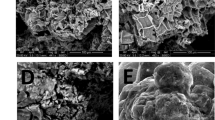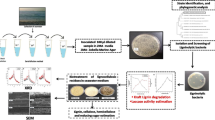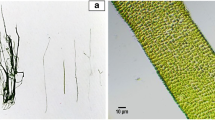Abstract
Global water scarcity at an alarming stage has triggered the interest of many environmentalists and global researchers. Use of freshwater in biomass-based industries would result in depletion of a precious natural resource, which is not sustainable in the long term. Thus, water management technologies are critical to the successful operation of an ethanol plant. Utilization of seawater-based systems and halotolerant enzymes can be a breakthrough in this context. The present study involves marine bacterial strains Bacillus oceanisediminis, Brevibacterium halotolerans, and Psychrobacter celer capable of producing halotolerant cellulases, isolated from Gopalpur, Odisha. The crude enzyme extracts and direct bacterial cultures were independently utilized for saccharification of pretreated rice straw, and the treated rice straw was characterized for the production of reducing sugars using high-performance liquid chromatography (HPLC). The possible bond breakage and formation during saccharification of cellulose was assessed using attenuated total reflectance with Fourier transform infrared (ATR-FTIR) spectroscopy. The relative fraction and size of crystallites in cellulose was evaluated by X-ray diffraction (XRD) study. The biomass saccharified using the crude cellulase from B. oceanisedimins was utilized for the production of bioethanol in freshwater and seawater-based media using Saccharomyces cerevisiae NCIM 3570 and Candida shehatae NCIM 3500. The maximum fermentation efficiency (45.74%) was recorded for saccharified rice straw in freshwater using a consortium of immobilized yeasts. The highest fermentation efficiency (36.69%) was recorded in the seawater system by immobilized S. cerevisiae.



Similar content being viewed by others
References
WWAP (United Nations World Water Assessment Programme) (2014) The United Nations world water development report 2014: water and energy. UNESCO, Paris
Indira D, Das B, Balasubramanian P, Jayabalan R. (2018) Sea water as a reaction medium for bioethanol production. In Patra JK, Das G, Shin HS (Eds.), Microbial Biotechnology: Application in Food and Pharmacology. (pp. 171-192). Singapore: Springer
Keeney D, Muller M (2006) Water use by ethanol plants: potential challenges. Institute for Agriculture and Trade Policy, Minneapolis, MN
Ren H, Zong MH, Wu H, Li N (2016) Utilization of seawater for the biorefinery of lignocellulosic biomass: ionic liquid pretreatment, enzymatic hydrolysis, and microbial lipid production. ACS Sustain Chem Eng 4(10):5659–5666
Lima RN, Porto ALM (2016) Recent advances in marine enzymes for biotechnological processes. In Advances in food and nutrition research (Vol. 78, pp. 153-192). Academic Press
Oren A (2010) Industrial and environmental applications of halophilic microorganisms. Environ Technol 3:825–834
Hutcheon GW, Vasisht N, Bolhuis A (2005) Characterisation of a highly stable a-amylase from the halophilic archaeon Haloarcula hispanica. Extremophiles 9:487–495
Oren A (2008) Microbial life at high salt concentrations: phylogenetic and metabolic diversity. Saline Syst 4(1):2
Trivedi N, Gupta V, Kumar M, Kumari P, Reddy CRK, Jha B (2010) An alkali-halotolerant cellulase from Bacillus flexus isolated from green seaweed Ulva lactuca. Carbohydr Polym 83(2):891–897
Grande PM, De Maria PD (2012) Enzymatic hydrolysis of microcrystalline cellulose in concentrated seawater. Bioresour Technol 104:799–802
Singhania RR, Sukumaran RK, Patel AK, Larroche C, Pandey A (2010) Advancement and comparative profiles in the production technologies using solid-state and submerged fermentation for microbial cellulases. Enzym Microb Technol 46(7):541–549
Yang H, Pfister S, Bhaduri A (2013) Accounting for a scarce resource: virtual water and water footprint in the global water system. Curr Opin Environ Sustain 5(6):599–606
Gerbens-Leenes W, Hoekstra AY, van der Meer TH (2009) The water footprint of bioenergy. Proc Natl Acad Sci 106(25):10219–10223
Gerbens-Leenes W, Hoekstra AY (2012) The water footprint of sweeteners and bio-ethanol. Environ Int 40:202–211
Zaky AS, Greetham D, Louis EJ, Tucker G, Du C (2016) A new isolation and evaluation method for marine-derived yeast spp. with potential applications in industrial biotechnology. J Microbiol Biotechnol 26(11):1891–1907
Greetham D, Zaky A, Makanjuola O, Du C (2018) A brief review on bioethanol production using marine biomass, marine microorganism and seawater. Curr Opin Green Sustain Chem 14: 53-59
Klement T, Milker S, Jäger G, Grande PM, de María PD, Büchs J (2012) Biomass pretreatment affects Ustilago maydis in producing itaconic acid. Microb Cell Fact 11(1): 43
Vom Stein T, Grande P, Sibilla F, Commandeur U, Fischer R, Leitner W, de María PD (2010) Salt-assisted organic-acid-catalyzed depolymerization of cellulose. Green Chem 12(10):1844–1849
Senthilraja P, Kathiresan K, Saravanakumar K (2011) Comparative analysis of bioethanol production by different strains of immobilized marine yeast. J Yeast Fungal Res 2(8):113–116
Urano N, Yamazaki M, Ueno R (2001) Distribution of halotolerant and/or fermentative yeasts in aquatic environments. J Tokyo Univ Fish 87:23–30
Gonçalves FA, Santos ESD, de Macedo GR (2015) Alcoholic fermentation of Saccharomyces cerevisiae, Pichia stipitis and Zymomonas mobilis in the presence of inhibitory compounds and seawater. J Basic Microbiol 55(6):695–708
Templeton D, Ehrman T (1995) Chemical analysis and testing task: LAP-003 (Determination of acid-insoluble lignin in Biomass) National Renewable Energy Laboratory. Golden, USA
Tailliez P, Girard H, Millet J, Beguin P (1989) Enhanced cellulose fermentation by an asporogenous and ethanol-tolerant mutant of Clostridium thermocellum. Appl Environ Microbiol 55(1):207–211
Indira D, Sharmila D, Balasubramanian P, Thirugnanam A, Jayabalan R (2016) Utilization of sea water based media for the production and characterization of cellulase by Fusarium subglutinans MTCC 11891. Biocatal Agric Biotechnol 7:187–192
Beecher JF, Hunt CG, Zhu JY (2009) Tools for the characterization of biomass at the nanometer scale, The nanoscience and technology of renewable biomaterials, 1st edn. Blackwell Publishing, Singapore, pp 61–80
Park S, Baker JO, Himmel ME, Parilla PA, Johnson DK (2010) Cellulose crystallinity index: measurement techniques and their impact on interpreting cellulase performance. Biotechnol Biofuels 3(1):10
Indira D, Jijnasa B, Arati N, Moumita S, Ajay D, Eldin J, Jayabalan R (2015) Comparative studies of ethanol production and cell viability: free cells versus immobilized cells. Res J Pharm Biol Chem Sci 6(2):1708–1714
Berłowska J, Pielech-Przybylska K, Balcerek M, Dziekońska-Kubczak U, Patelski P, Dziugan P, Kręgiel D (2016) Simultaneous saccharification and fermentation of sugar beet pulp for efficient bioethanol production. BioMed Res Intl 2016, 3154929, 10 pages.
Chandel AK, Chan EC, Rudravaram R, Narasu ML, Rao LV, Ravindra P (2007) Economics and environmental impact of bioethanol production technologies: an appraisal. Biotechnol Mol Biol 2:14–32
Sukumaran RK, Singhania RR, Mathew GM, Pandey A (2009) Cellulase production using biomass feed stock and its application in lignocellulose saccharification for bio-ethanol production. Renew Energy 34(2):421–424
Ko JK, Bak JS, Jung MW, Lee HJ, Choi IG, Kim TH, Kim KH (2009) Ethanol production from rice straw using optimized aqueous-ammonia soaking pretreatment and simultaneous saccharification and fermentation processes. Bioresour Technol 100(19):4374–4380
Zaky AS, Pensupa N, Andrade-Eiroa Á, Tucker GA, Du C (2017) A new HPLC method for simultaneously measuring chloride, sugars, organic acids and alcohols in food samples. J Food Compos Anal 56:25–33
Michell AJ, Schimleck LR (1996) NIR spectroscopy of woods from Eucalyptus globules. Appita J 49(1):23–26
Baillères H, Davrieux F, Ham-Pichavant F (2002) Near infrared analysis as a tool for rapid screening of some major wood characteristics in a eucalyptus breeding program. Ann For Sci 59(5–6):479–490
Adina CHIŞ, Florinela FETEA, Abdelmoumen TAOUTAOU, Carmen S (2010) Application of FTIR spectroscopy for a rapid determination of some hydrolytic enzymes activity on sea buckthorn substrate. Rom Biotechnol Lett 15(6):5738–5744
Xu F, Yu J, Tesso T, Dowell F, Wang D (2013) Qualitative and quantitative analysis of lignocellulosic biomass using infrared techniques: a mini-review. Appl Energy 104:801–809
Schwanninger M, Rodrigues J, Pereira H, Hinterstoisser B (2004) Effects of short time vibratory ball milling on the shape of FT-IR spectra of wood and cellulose. Vib Spectrosc 36:23–40
Kubo S, Kadla JF (2005) Hydrogen bonding in lignin: a Fourier transform infrared model compound study. Biomacromolecules 6:2815–2821
Sills DL, Gossett JM (2012) Using FTIR to predict saccharification from enzymatic hydrolysis of alkali pretreated biomasses. Biotechnol Bioeng 109:353–362
Binod P, Satyanagalakshmi K, Sindhu R, Janu KU, Sukumaran RK, Pandey A (2012) Short duration microwave assisted pretreatment enhances the enzymatic saccharification and fermentable sugar yield from sugarcane bagasse. Renew Energy 37(1):109–116
Karthika K, Arun AB, Rekha PD (2012) Enzymatic hydrolysis and characterization of lignocellulosic biomass exposed to electron beam irradiation. Carbohydr Polym 90(2):1038–1045
Mittal A, Katahira R, Himmel ME, Johnson DK (2011) Effects of alkaline or liquidammonia treatment on crystalline cellulose: changes in crystalline structure and effects on enzymatic digestibility. Biotechnol Biofuels 4:41
Singh J, Suhag M, Dhaka A (2015) Augmented digestion of lignocellulose by steam explosion, acid and alkaline pretreatment methods: a review. Carbohydr Polym 117:624–631
Sindhu R, Kuttiraja M, Binod P, Janu KU, Sukumaran RK, Pandey A (2011) Dilute acid pretreatment and enzymatic saccharification of sugarcane tops for bioethanol production. Bioresour Technol 102(23):10915–10921
Samuel R, Pu Y, Foston M, Ragauskas AJ (2010) Solid-state NMR characterization of switchgrass cellulose after dilute acid pretreatment. Biofuels 1(1):85–90
Zhang T, Datta S, Eichler J, Ivanova N, Axen SD (2011) Identification of a haloalkaliphilic and thermostable cellulase with improved ionic liquid tolerance. Green Chem 13:2083–2090
Cao Y, Tan HJ (2004) Structural characterization of cellulose with enzymatic treatment. J Mol Struct 705:189–193
Kshirsagar SD, Waghmare PR, Loni PC, Patil SA, Govindwar SP (2015) Dilute acid pretreatment of rice straw, structural characterization and optimization of enzymatic hydrolysis conditions by response surface methodology. RSC Adv 5(58):46525–46533
Hohmann S (2002) Osmotic stress signaling and osmoadaptation in yeasts. Microbiol Molbiol Rev 66(2):300–372
Zaky AS, Greetham D, Tucker GA, Du C (2018) The establishment of a marine focused biorefinery for bioethanol production using seawater and a novel marine yeast strain. Sci Rep 8(1):12127
Fang C, Thomsen MH, Brudecki GP, Cybulska I, Frankaer CG, Oyanedel JRB, Schmidt JE (2015) Seawater as an alternative to fresh water in the pretreatment of date palm residues for bioethanol production in coastal and/or arid areas. ChemSusChem 8(22):3823–3831
Lau MW, Dale BE (2009) Cellulosic ethanol production from AFEX-treated corn stover using Saccharomyces cerevisiae 424A (LNH-ST). Proc Nat Acad Sci 106(5):1368–1373
Fu N, Peiris P (2008) Co-fermentation of a mixture of glucose and xylose to ethanol by Zymomonas mobilis and Pachysolen tannophilus. World J Microbiol Biotechnol 24:1091–1097
Qian M, Tian S, Li X, Zhang J, Pan Y, Yang X (2006) Ethanol production from dilute acid softwood hydrolysate by co-culture. Appl Biochem Biotechnol 134:273–283
Lebeau T, Jouenne T, Junter GA (1997) Simultaneous fermentation of glucose and xylose by pure and mixed cultures of Saccharomyces cerevisiae and Candida shehatae immobilized in a two-chambered bioreactor. Enzym Microb Technol 21:265–272
Grootjen DRJ, Jansen ML, van der Lans RGJM, Luyben KCAM (1991) Reactors in series for the complete conversion of glucose/xylose mixtures by Pichia stipitis and Saccharomyces cerevisiae. Enzym Microb Technol 13:828–833
Laplace JM, Delgenes JP, Moletta R, Navarro JM (1993) Cofermentation of glucose and xylose to ethanol by a respiratory-deficient mutant of Saccharomyces cerevisiae co-cultivated with a xylose-fermenting yeast. J Ferment Bioeng 75:207–212
De Bari I, Cuna D, Nanna F, Braccio G (2004) Ethanol production in immobilized-cell bioreactors from mixed sugar syrups and enzymatic hydrolysates of steam-exploded biomass. Appl Biochem Biotechnol 114:539–557
Hohmann S, Krantz M, Nordlander B (2007) Yeast osmoregulation. Methods Enzymol 428:29–45
Greetham D, Zaky AS, Du C (2019) Exploring the tolerance of marine yeast to inhibitory compounds for improving bioethanol production. Sustain Energy Fuels 3(6):1545–1553
Acknowledgments
The authors gratefully acknowledge the financial support and laboratory facilities from the Department of Life Science, National Institute of Technology, Rourkela, Odisha.
Author information
Authors and Affiliations
Corresponding author
Ethics declarations
Conflict of interest
The authors declare that they have no conflict of interest.
Additional information
Publisher’s note
Springer Nature remains neutral with regard to jurisdictional claims in published maps and institutional affiliations.
Electronic supplementary material
ESM 1
(DOCX 5675 kb)
Rights and permissions
About this article
Cite this article
Indira, D., Jayabalan, R. Saccharification of lignocellulosic biomass using seawater and halotolerant cellulase with potential application in second-generation bioethanol production. Biomass Conv. Bioref. 10, 639–650 (2020). https://doi.org/10.1007/s13399-019-00468-4
Received:
Revised:
Accepted:
Published:
Issue Date:
DOI: https://doi.org/10.1007/s13399-019-00468-4




